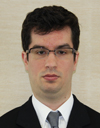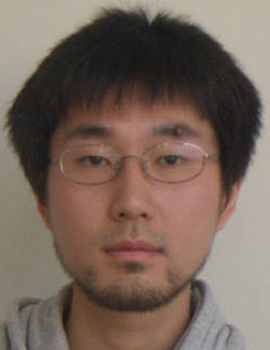
Gennadiy Nikishkov
Professor

Pierre-Alain Fayolle
Assistant Professor

Yohei Nishidate
Assistant Professor

Gennadiy Nikishkov Professor |

Pierre-Alain Fayolle Assistant Professor |

Yohei Nishidate Assistant Professor |
The Computer Graphics Lab conducts research into physics-based modeling of different phenomena, their visualization and animation. Innovative approaches to graphical user interfaces and direct interaction methods, modeling, rendering, simulation and scientific visualization are under development. Created mathematical models are used for graphical representation of natural processes.
Research areas include:
Visualization of surface and volume data, which results from finite element, boundary element and finite difference modeling.
Nanomechanics modeling. Finite element and molecular mechanics modeling of micro- and nanostructures.
Augmented reality interface for different fields of human activity.
Using graphics processing units for physics-based modeling and animation.
Development of algorithms for shape modeling, analysis and understanding (operations on shape, segmentation and reconstruction).
Investigation of algorithms for the polygonization of implicit surfaces (adaptative and robust polygonization, fast polygonization).
Professors of the Computer Graphics Laboratory deliver courses in Computer Graphics, Numerical Analysis, Modeling and Visualization. Graduation projects are related to computer graphics, human-computer interaction, physics-based modeling, visualization, and animation.
P.-A. Fayolle and A. Pasko. Optimized surface discretization of functionally defined multi-material objects. Advances in Engineering Software, 45(1):301-312, 2012.
We present in this paper an algorithm for meshing implicit surfaces based on the Delaunay triangulation of a point-set adaptively sampled on an implicit surface. To improve the quality of the resulting triangular mesh, we use at each iteration a mesh optimization algorithm with the following objectives: optimizing the connectivity, retrieving the sharp features, regularizing the triangles shapes and minimizing the approximation error. Then, we extend this algorithm in order to handle functionally defined heterogeneous object surfaces, while maintaining a good quality for the triangles’ shapes and the mesh features (geometrical sharp features and boundaries between different materials).
P.-A. Fayolle and A. Pasko. Distance based modeling and visualization of objects built with set operations. Scientific Visualization, 3(3):23-33, 2011.
We present in this paper methods to compute the signed Euclidean distance to surfaces obtained by the intersection (respectively union or difference) of two solids (in two or three dimensions). These implementations can replace min/max or Rfunctions traditionally used to model set operations used with implicit surfaces.
J. H. Park and G. P. Nikishkov. Growth simulation for 3D surface and through-thickness cracks using SGBEM-FEM alternating method. Journal of Mechanical Science and Technology, 25:2335-2344, 2011.
SGBEM-FEM alternating method had been proposed by Nikishkov, Park and Atluri for the analysis of three-dimensional planar and non-planar cracks and their growth. The proposed method is an effective method for fatigue or stress corrosion crack growth simula- tion. During crack growth simulation, however, an oscillation phenomenon is observed in crack advance or stress intensity factor distri- bution. If oscillating amplitude in SIF or crack advance does not decrease during next increment steps, the crack growth simulation fails. In this paper several methods are examined to remove the oscillation phenomenon. As a result, it is found that smoothing in stress inten- sity factor distribution or in crack front geometry can remove or weaken the oscillation phenomenon. Using the smoothing techniques, stress corrosion crack growth simulation is performed for a semi-elliptical surface crack and a throughthickness crack embedded in a plate. It is noted that the SGBEM-FEM alternating method is a very effective method for SCC growth simulation for a surface crack and a through-thickness crack.
J. H. Park and G. P. Nikishkov. Modeling and analysis of arbitrarily shaped three-dimensional cracks. Transactions of KSME A, 35:1091-1097, 2011.
The SGBEM-FEM alternating method has been known to be a very effective method for analyzing three- dimensional cracks in a finite body. The accurate values of the stress intensity factor can be obtained for a general planar or nonplanar threedimensional crack. In the existing method, eight-noded quadrilateral boundary elements are used to model a crack. In some cases, three-node triangle boundary elements are more convenient for the modeling of a crack with a general shape. In this study, a crack is modeled with three-noded triangular and seven-noded quadrilateral elements by using the advancing-front mesh generation method. The stress intensity factors are obtained for cracks of several shapes and the accuracy of results is examined.
Y. Nishidate, T. Nagata, S. Morita, and Y. Yamagata. Ray-tracing method for isotropic inhomogeneous refractive-index media from arbitrary discrete input. Applied Optics, 50(26):5192-5199, 2011.
We have developed a ray-tracing simulation procedure for optically isotropic gradient refractive-index media. The procedure can take discrete points of arbitrary distribution for the definition of refractiveindex distributions and lens surfaces. It is useful for simulating ray trajectories in real lens systems. The procedure is applied to a ray-tracing simulation of the Luneburg lens and a radial gradient optical fiber. The simulation results are compared with the analytical solutions, and it is shown that they are in precise agreement
G. P. Nikishkov. Visualization of results in higher-order finite elements. In The 11th Asian Symposium on Visualization, pages ASV11-99-08, 4 pp., Niigata, Japan, 5-9 June 2011.
An algorithm for visualization of models and results for three-dimensional higherorder finite elements is presented. The algorithm is based on adaptive subdivision of element faces into triangles. The density of triangular subdivision depends upon surface curvature and results gradients. Results are visualized as color contours using texture interpolation. The visualization program is implemented in Java programming language. The JOGL API is used for rendering three-dimensional scenes.
Gennadiy Nikishkov and Yohei Nishidate. Water surface animation using damped wave equation and CUDA acceleration. In Proceedings of 2011 World Congress on Engineering and Technology (CET 2011), pages 249-252, Shanghai, China, 28 Oct2 Nov 2011.
The damped wave equation is used for simulating water waves. The differential equation is approximated by finite differences. Explicit integration produces water height fields in real time. The CUDA framework is used to perform parallel computations on the GPU. It is shown that the GPU provides considerable speedup in comparison to the CPU.
Y. Nishidate. Kanto Bureau of Economy, Trade and Industry, 2012.
P.-A. Fayolle, 2011.
Reviewer for Computer-Aided-Design
P.-A. Fayolle, 2011.
Reviewer for Engineering with Computers
Gennadiy Nikishkov, 2011.
Member of the Editorial Board, International Journal 'Computer Modeling in Engineering and Sciences'.
Gennadiy Nikishkov, April 2011.
Member of the International Organizing Committee, Int. Conf. on Computational and Experimental Engineering and Sciences ICCES 2011, Nanjing, China.
Gennadiy Nikishkov, February 2012.
Member of the Program Committee, Int. Conf. on Computer Graphics Theory and Applications GRAPP 2012, Rome, Italy.
Gennadiy Nikishkov, August-September 2011.
Member of the Program Committee, The 11th IEEE International Conference on Computer and Information Technology (CIT 2011), Pafos, Cyprus.
Gennadiy Nikishkov, April 2011.
The Second International Conference on Parallel, Distributed, Grid and Cloud Computing for Engineering PARENG 2011, Ajaccio, Corsica, France.
Gennadiy Nikishkov, 2011.
Reviewer, Computer Modeling in Engineering and Sciences.
Gennadiy Nikishkov, 2011.
Reviewer, Measurement Science and Technology.
Gennadiy Nikishkov, 2011.
Reviewer, The Arabian Journal for Science and Engineering, Springer.
Y. Nishidate, March 2012.
Reviewer, Applied Optics
Y. Nishidate, January 2012.
Reviewer, Applied Optics
Yasuaki Ohama. Augmented reality game using Wii remote. Graduation Thesis, School of Computer Science and Engineering, 2012.
Thesis Adviser: Gennadiy Nikishkov
Ryo Sonoda. Visualization of carbon nanostructures. Graduation Thesis, School of Computer Science and Engineering, 2012.
Thesis Adviser: Gennadiy Nikishkov
Nobuhiro Nakahisa. 3D car parking simulation using JOGL. Graduation Thesis, School of Computer Science and Engineering, 2012.
Thesis Adviser: Gennadiy Nikishkov

2012 THE UNIVERSITY OF AIZU ALL RIGHTS RESERVED